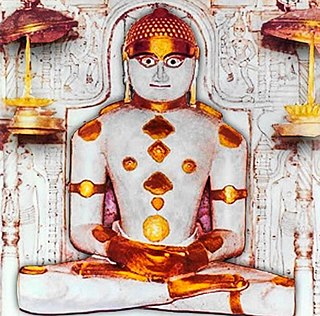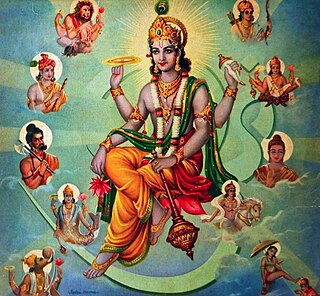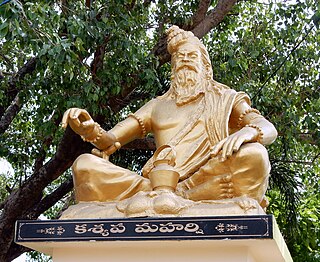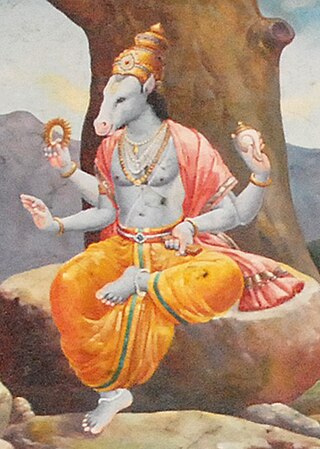
Indra is the king of the devas and Svarga in Hinduism. He is associated with the sky, lightning, weather, thunder, storms, rains, river flows, and war. He is a rough equivalent to Zeus in Greek mythology, or Jupiter in Roman mythology. Indra's powers are similar to other Indo-European deities such as Norse Odin, Perun, Perkūnas, Zalmoxis, Taranis, and Thor, part of the greater Proto-Indo-European mythology.

Balarama is a Hindu god. The elder brother of Vāsudeva-Krishna he is described in the Bhagavata Purana as the highest form of divinity that expanded into Vishnu and creation. He is particularly significant in the Jagannath tradition, as one of the triad deities. He is also known as Haladhara, Halayudha, Baladeva, Balabhadra, and Sankarshana.

Matsya is the fish avatar of the Hindu god Vishnu. Often described as the first of Vishnu's ten primary avatars, Matsya is described to have rescued the first man, Manu, from a great deluge. Matsya may be depicted as a giant fish, often golden in color, or anthropomorphically with the torso of Vishnu connected to the rear half of a fish.

Angiras or Angira was a Vedic rishi (sage) of Hinduism. He is described in the Rigveda as a teacher of divine knowledge, a mediator between men and gods, as well as stated in other hymns to be the first of Agni-devas. In some texts, he is considered to be one of the seven great sages or Saptarishis, but in others he is mentioned but not counted in the list of seven great sages. In some manuscripts of Atharvaveda, the text is attributed to "Atharvangirasah", which is a compound of sage Atharvan and Angira. The student family of Angira are called "Angira", and they are credited to be the authors of some hymns in the first, second, fifth, eighth, ninth, and tenth books of the Rigveda. By the time of the composition of the Rigveda, the Angirases were an old Rishi clan, and were stated to have participated in several events.

Avatar is a concept within Hinduism that in Sanskrit literally means 'descent'. It signifies the material appearance or incarnation of a powerful deity, or spirit on Earth. The relative verb to "alight, to make one's appearance" is sometimes used to refer to any guru or revered human being.

Atri or Attri is a Vedic sage, who is credited with composing numerous hymns to Agni, Indra, and other Vedic deities of Hinduism. Atri is one of the Saptarishi in the Hindu tradition, and the one most mentioned in its scripture Rigveda.
Manu is a term found with various meanings in Hinduism. In early texts, it refers to the archetypal man, or to the first man. The Sanskrit term for 'human', मनुष्य or मानव means 'of Manu' or 'children of Manu'. In later texts, Manu is the title or name of fourteen rulers of earth, or alternatively as the head of dynasties that begin with each cyclic kalpa (aeon) when the universe is born anew. The title of the text Manusmriti uses this term as a prefix, but refers to the first Manu – Svayambhuva, the spiritual son of Brahma. In the Hindu cosmology, each kalpa consists of fourteen Manvantaras, and each Manvantara is headed by a different Manu. The current universe, is asserted to be ruled by the 7th Manu named Vaivasvata. Vaivasvata was the king of Dravida before the great flood. He was warned of the flood by the Matsya (fish) avatar of Vishnu, and built a boat that carried the Vedas, Manu's family and the seven sages to safety, helped by Matsya. The tale is repeated with variations in other texts, including the Mahabharata and a few other Puranas. It is similar to other floods such as those associated with Gilgamesh and Noah.
Āstika and nāstika are concepts that have been used to classify the schools of Indian philosophy by modern scholars, as well as some Hindu, Buddhist and Jain texts. The various definitions for āstika and nāstika philosophies have been disputed since ancient times, and there is no consensus. One standard distinction, as within ancient- and medieval-era Sanskrit philosophical literature, is that āstika schools accept the Vedas, the ancient texts of India, as fundamentally authoritative, while the nāstika schools do not. However, a separate way of distinguishing the two terms has evolved in current Indian languages like Telugu, Hindi and Bengali, wherein āstika and its derivatives usually mean 'theist', and nāstika and its derivatives denote 'atheism'. Still, philosophical tradition maintains the earlier distinction, for example, in identifying the school of Sāṃkhya, which is non-theistic, as āstika (Veda-affirming) philosophy, though "God" is often used as an epithet for consciousness (purusha) within its doctrine. Similarly, though Buddhism is considered to be nāstika, Gautama Buddha is considered an avatar of the god Vishnu in some Hindu denominations. Due to its acceptance of the Vedas, āstika philosophy, in the original sense, is often equivalent to Hindu philosophy: philosophy that developed alongside the Hindu religion.

Rishabhanatha, also Rishabhadeva, Rishabha or Ikshvaku, is the first tirthankara of Jainism. He was the first of twenty-four teachers in the present half-cycle of time in Jain cosmology, and called a "ford maker" because his teachings helped one cross the sea of interminable rebirths and deaths. The legends depict him as having lived millions of years ago. He was the spiritual successor of Sampratti Bhagwan, the last Tirthankar of previous time cycle. He is also known as Ādinātha, as well as Adishvara, Yugadideva, Prathamarajeshwara and Nabheya. He is also known as Ikshvaku, establisher of Ikshvaku dynasty. Along with Mahavira, Parshvanath, Neminath, and Shantinath, Rishabhanatha is one of the five Tirthankaras that attract the most devotional worship among the Jains.

In Hinduism, the concept of God varies in its diverse religio-philosophical traditions. Hinduism comprises a wide range of beliefs about God and Divinity, such as henotheism, monotheism, polytheism, panentheism, pantheism, pandeism, monism, agnosticism, atheism, and nontheism.

The Buddha is considered the ninth avatar among the ten major avatars of the god Vishnu, according to the Vaishnava tradition of Hinduism.

Vaishnavism is one of the major Hindu denominations along with Shaivism, Shaktism, and Smartism. It is also called Vishnuism since it considers Vishnu as the sole supreme being leading all other Hindu deities, that is, Mahavishnu. Its followers are called Vaishnavites or Vaishnavas, and it includes sub-sects like Krishnaism and Ramaism, which consider Krishna and Rama as the supreme beings respectively. According to a 2010 estimate by Johnson and Grim, Vaishnavism is the largest Hindu sect, constituting about 641 million or 67.6% of Hindus.
Jainism is a religion founded in ancient India. Jains trace their history through twenty-four tirthankara and revere Rishabhanatha as the first tirthankara. The last two tirthankara, the 23rd tirthankara Parshvanatha and the 24th tirthankara Mahavira are considered historical figures. According to Jain texts, the 22nd tirthankara Neminatha lived about 5,000 years ago and was the cousin of Krishna.

The Dashavatara are the ten primary avatars of Vishnu, a principal Hindu god. Vishnu is said to descend in the form of an avatar to restore cosmic order. The word Dashavatara derives from daśa, meaning "ten", and avatāra, roughly equivalent to "incarnation".

Vishnu, also known as Narayana and Hari, is one of the principal deities of Hinduism. He is the supreme being within Vaishnavism, one of the major traditions within contemporary Hinduism.

In Hinduism, Adityas, refers to the offspring of Aditi, the goddess representing the infinity. The name Aditya, in the singular, is taken to refer to the sun god Surya. Generally, Adityas are twelve in number and consists of Vivasvan, Aryaman, Tvashta, Savitr, Bhaga, Dhata, Mitra, Varuna, Amsa, Pushan, Indra and Vishnu.

Kashyapa is a revered Vedic sage of Hinduism. He is one of the Saptarishis, the seven ancient sages of the Rigveda. Kashyapa is the most ancient and venerated rishi, along with the other Saptarishis, listed in the colophon verse in the Brihadaranyaka Upanishad.
According to the Jain cosmology, the Śalākāpuruṣa "illustrious or worthy persons" are 63 illustrious beings who appear during each half-time cycle. They are also known as the triṣaṣṭiśalākāpuruṣa. The Jain universal or legendary history is a compilation of the deeds of these illustrious persons. Their life stories are said to be most inspiring.
Jainism and Hinduism are two ancient Indian religions. There are some similarities and differences between the two religions. Temples, gods, rituals, fasts and other religious components of Jainism are different from those of Hinduism.

Hayagriva Upanishad or Hayagrivopanishad is one of 108 Upanishad, written in Sanskrit language. It is a minor Upanishad, dedicated to Hayagriva – the horse-faced avatar of the god Vishnu. It belongs to the Vaishnava sect, which worships Vishnu, and is associated with the Atharvaveda.











